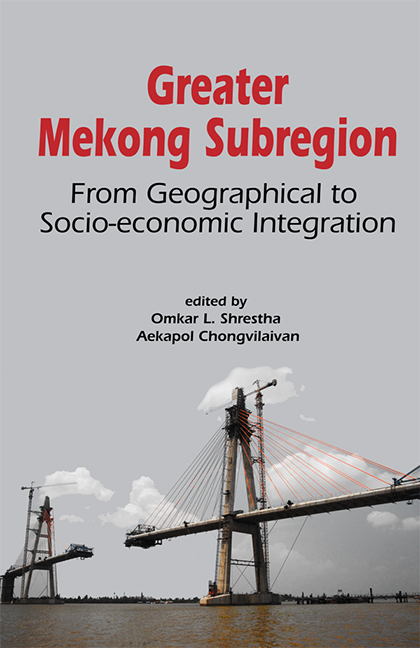Book contents
- Frontmatter
- Contents
- Preface
- List of Abbreviations
- Contributors
- 1 Greater Mekong Subregion: From Geographical Corridors to Socio-economic Corridors
- 2 Cambodia, Its Development, and Integration into the GMS: A Work in Progress
- 3 Subregional Connectivity in the Lao PDR: From Land-locked Disadvantage to Land-linked Advantage
- 4 The Economic Development of Myanmar and the Relevance of the Greater Mekong Subregion
- 5 GMS Challenges for Thailand
- 6 Deepening GMS Cooperation in a More Integrated ASEAN and East Asia
- 7 China (Yunnan)–GMS Economic Cooperation: New Development and New Problems
- 8 Trade and Investment in the Greater Mekong Subregion: Remaining Challenges and the Unfinished Policy Agenda
- 9 Enhancing Financial Cooperation among the GMS Countries
- 10 The Challenges of GMS Regional Integration: Case Study of Governance of the Logistics Industry in Thailand
- 11 Energy Sector Integration for Low-carbon Development in the GMS: Towards a Model of South-South Cooperation
- 12 Linking the Social to the Economic: Broadened Ambitions and Multiple Mitigations in New Mekong Corridors
- Index
Preface
Published online by Cambridge University Press: 21 October 2015
- Frontmatter
- Contents
- Preface
- List of Abbreviations
- Contributors
- 1 Greater Mekong Subregion: From Geographical Corridors to Socio-economic Corridors
- 2 Cambodia, Its Development, and Integration into the GMS: A Work in Progress
- 3 Subregional Connectivity in the Lao PDR: From Land-locked Disadvantage to Land-linked Advantage
- 4 The Economic Development of Myanmar and the Relevance of the Greater Mekong Subregion
- 5 GMS Challenges for Thailand
- 6 Deepening GMS Cooperation in a More Integrated ASEAN and East Asia
- 7 China (Yunnan)–GMS Economic Cooperation: New Development and New Problems
- 8 Trade and Investment in the Greater Mekong Subregion: Remaining Challenges and the Unfinished Policy Agenda
- 9 Enhancing Financial Cooperation among the GMS Countries
- 10 The Challenges of GMS Regional Integration: Case Study of Governance of the Logistics Industry in Thailand
- 11 Energy Sector Integration for Low-carbon Development in the GMS: Towards a Model of South-South Cooperation
- 12 Linking the Social to the Economic: Broadened Ambitions and Multiple Mitigations in New Mekong Corridors
- Index
Summary
It has been nearly two decades since the Greater Mekong Subregion (GMS) regional economic strategy was initiated in 1992, aimed at promoting and integrating the economies of Cambodia, the Lao PDR, Myanmar, Thailand, Vietnam, and Yunnan Province and Guangxi autonomous region of China. Together, they encompass a huge population of over 316 million people (bigger than the United States) and a vast land area of around 2.6 million square kilometres (roughly the size of Europe), enjoying a rich agricultural base, considerable mineral and energy resources (renewable and non-renewable), and a strategic location at the heart of Asia between the burgeoning economies of China and India.
Several regional infrastructure projects in the transport and energy sectors have facilitated the process of integration of the GMS economies. For instance, the 1,320-kilometre-long East-West Economic Corridor cross-border project, triggered by the landmark trade accord signed in 1999, stretches from Danang in Vietnam, through the Lao PDR and Thailand to Myanmar, forming a land bridge connecting the South China Sea at Danang Port to the Andaman Sea at Mawlamyine Port in Myanmar. There is a growing recognition that these cross-border infrastructure projects have helped raise the GMS economies’ degree of connectivity and competitiveness, achieve accelerated shared prosperity, and expand intraregional trade and investment activities. Indeed there is a widely held perception that Asia's success story is not only about rise in income and decline in poverty, but is also the story of increased integration among the regional countries through various regional and subregional infrastructure projects.
Enhanced regional integration and cooperation also help build resilient economies through well-coordinated and timely responses to global crises. Hence, notwithstanding the recent international financial crisis, several GMS countries have made remarkable achievement in terms of their sustained economic growth (6 to 10 per cent per year) for the past decade. The intraregional trade among the GMS countries is now estimated at 30–50 per cent of their total trade. Foreign direct investment flows to the GMS countries have increased considerably and so have tourist arrivals.
Despite the above positive developments, several of the GMS economies remain the weakest link in the ASEAN chain. The economic divide that exists between these economies and other ASEAN nations remains a major concern for the ASEAN quest to achieve the ASEAN Economic Community vision by the year 2015.
- Type
- Chapter
- Information
- Greater Mekong SubregionFrom Geographical to Socio-economic Integration, pp. vii - xPublisher: ISEAS–Yusof Ishak InstitutePrint publication year: 2013



